#benjamin escher
Text
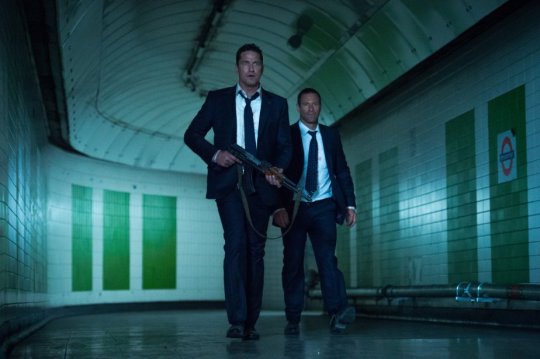

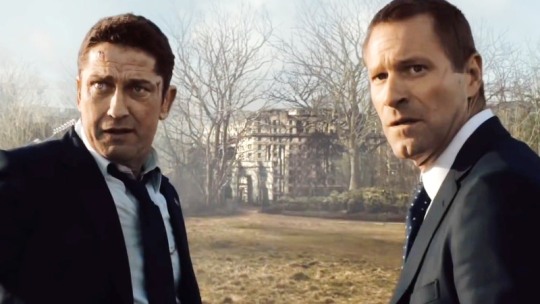
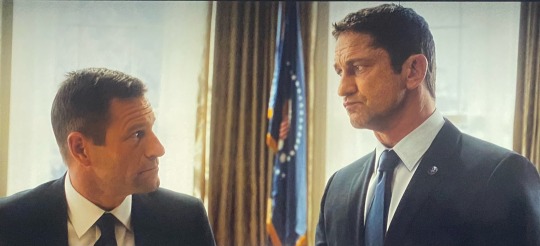


The unintentional homo-eroticism of these movies (seen for the first time this weekend) now means I must write something for this teensy but lovely fandom.
20 notes
·
View notes
Text
friends said my haircut makes me look like Paul Dano I’m just gonna go walk into traffic now ig
3 notes
·
View notes
Text
My Lordsona’s letters, diary entries, and journal entry in Mother Miranda’s Lab.
I remembered that in each of the lords’ areas, there tends to be letters/journal entries/notes that are either about them or that they wrote themselves in addition to what Mother Miranda wrote about each one in her lab. I thought it would be fun to make some for my lordsona as a way to add additional information (including what could have lead to getting a cadou in the first place, because I don’t think those are given out so freely).
There is mentions of @artistcaptainbendy‘s lordsona Bendypants and their OC Benjamin.
TW: Mentions of gore
(All journal entries located in personal studio in the gallery. Some would hold clues to solving certain puzzles.)
Journal 1
May 3rd, 1968
(page 1)
I would rather swim in Moreau’s lake and be subjected to whatever goes on in Donna’s estate than give another art lesson to Alcina’s girls. She hoped I could cultivate some talent in the three of them, and there was some promise in both Cassandra and Daniela. Bela seemed disinterested and wanted to go to the piano instead. There was some frustration over the past few weeks and it made me thankful I’m their ‘aunt’ or else it wouldn’t have ended well for me.
Weeks later, they presented me with some abominable displays. That one ‘statue’ looked like one of the maids... or what was left of the poor woman. And I doubt that was red paint used on that canvas.
I don’t mind speaking with Alcina herself once in awhile when I want a bit of class and elegance. There’s certainly no denying her sense of taste in decor and her collection of artwork is incredible. But her daughters are too much for me and I don’t agree on her views of all men. She certainly never met my father or my...
(page 2)
Father....
Sorry, I got lost in my memories there for a bit. Tomorrow I am meeting with some of the village children and will give them an art lesson. They are more of a delight compared to those poor excuses for children in that castle.
They admire the other lords, but its possibly for the best that they aren’t allowed to get too close to them.
Reminder to self: Check to see if the Duke has any works of art to add to the gallery when he comes back.
Journal 2
September 2nd 1975
(Page 1)
It appears I finally have a new security guard. The bastard and a friend of his thought he could sneak into MY gallery and steal a painting that I said would cost a fortune. They fell victim to the Escher trap (clearly they didn’t pay attention to his surroundings) and the painting was destroyed.
All that trouble for a Van Gough replica that’d be worth not even a fraction of the true painting.
But then again, what should I have expected from the son of the drunkard who nearly paralyzed me for life with a bullet to the spine and sent me into Mother Miranda?
The man was completely brain dead. The friend was a bloodied mess, but I stitched his arms to the thief, added some details of my own, did a bit of fixing up, and used a Cadou. He’s dull as a rock and doesn’t recall his past life, but he’ll be good at protecting my gallery from other idiots.
I call him David after the famous statue.
September 5th, 1975
(Page 2)
Unsurprisingly, Heisenberg thought my creation was, and I quote ‘a hunk of shit and dumbassery mixed together’ and said he could have done so much better. Unlike him, MY creations ARE true works of art. Of course I’m not interested in getting into an argument with him as he enjoys doing so with Alcina.
I brought David to someone else who’d be fascinated with him. Bendypants seemed intrigued and wondered if I could lend David to them to help build a set.
I’m deeply disturbed that I’ve sunk as low as the others. I didn’t think I’d actually use a cadou but I try to tell myself that what I’ve done was a fitting punishment. Besides, it keeps Mother Miranda off my back for a bit.
Note to self: Need to do something about the additional arms on David. They don’t look like they are as secure as I would like them to be.
October 10th, 1975
(Page 3)
It turns out David developed a soft spot for Benjamin. As in Bendypants’ favorite lycan. He’s been looking at him like a girl harboring a secret crush.
That was.... rather unexpected. I guess David isn’t as dull as I thought. I need to keep an eye on him in case he remembers anything about his former life.
Journal 3
January 20th, 2004
(Page 1)
Karl is crude and a bit much at times. But there’s no denying that he’s rather handsome and I finally was able to convince him to pose for some sketches for a painting after all these years. It took the finest bottle of whiskey the Duke had on hand to convince him.
Bendypants will be so envious of me. They too have a certain soft spot for our fellow lord. Perhaps I can gift them with a replica painting as a present in the future.
I admire that Heisenberg doesn’t bother putting on airs like Alcina and his.... extraverted nature is a breath of fresh air. However the whiskey caused him to spill something rather concerning. He seemed unusually interested in my family’s plot of land in the graveyard.
I’m very concerned about what his intentions are.
(Page 2)
I just paid the gravekeeper to unearth the remains of my family so I can burn them and bury them under the oak tree.
I am NOT letting any of the lords use my family’s remains for whatever they are planning.
March 15th, 2010
(Page 3)
Bendypants invited me to one of their plays. It was ‘A Midsummer Nights Dream.’ It was a delight and helped me take my mind off things. The idea of making some of the characters not quite fit into certain norms that are expected in the village would have made Mother Miranda squirm.
I showed them that painting of Ophelia drowning when we discussed Shakespeare the next day. Sometimes I wonder why the cadou didn’t make me lose my mind like Ophelia–would I have been happier without my sanity in the village, amongst the others? At least I wouldn’t have been aware of what sins I would be committing across the years.
I have deeply cherished my friendship with them. They were there at the funerals for each family member of mine who died. Their condolences were honest compared to the other lords and those who were trying to kiss up to me. Like me, they too have somehow defied time’s cruelty to the body, and have known the loss of a loved one.
(Page 4)
The children are the only others in the village that I am fond of and would protect. Such innocence to the violence hidden in the corners. Sometimes I wish to give into the desire of motherhood, but that would have been the greatest pain I could experience....
(letter hidden in Lord Bendypants’ theater)
Dearest B,
Regardless of what Miranda tells us lords, you are the only true family I have left in this forsaken village. I would have never imagined that wild, mud covered child of the woods would be the one person I could trust.
That woman never was and will NEVER be my mother. Regardless of what she gave to me, I had to watch my family succumb to old age and sickness while I still remain as I am–a Venus forever frozen in youth and beauty. I hope she burns in hell for her sins and for what she has turned me into across the years.
I suspect that whatever she wants with the infant she kept mentioning is not going to end well for us or the village. She is charismatic, but her lack of true warmth makes me uneasy. I get the feeling that death is certain, but as to who for is not clear yet. I have two requests for you if my suspicions are correct.
First, I am going to see if I can hide any children I can find. They were one of the few things that made me happy here and do not deserve whatever Miranda has planned, so I shall sneak them in a room within my gallery. Please do not let any of your lycans harm the children or attack me tomorrow night. Should things go according to plan, they will be able to have the true freedom that was denied to all of us.
Secondly, should I perish from whatever Miranda has in store, retrieve my body, burn it, and bury it under THAT oak tree where I placed the ashes of my family. I think I finally know for sure who was getting into the graves lately, but I will be damned if I let that asshole take my body too.
I will never forget our times together, or the visits to your wonderful theater. Thank you for being there when I needed it the most.
Your friend,
-R
(Journal in Miranda’s lab)
Subject Name: _______ Rose
Cadou Affinity: Somewhat Favorable
Brain Function: Normal
Subject’s spinal chord was damaged by a gunshot wound three days before procedure. Subject has regained full mobility after cadou implantation. Six horn like protrusions have grown out of subject’s skull, yet subject hasn’t suffered any damage to the brain.
Subject’s arms mutate into an armor and bone fragments extend out of limbs like thorns that are strong enough to tear through flesh when provoked. These abilities are somewhat similar to Alcina’s but pales in comparison to what she is capable of.
Insect-like wings extend right out of subject’s backside when the subject wills them to, yet immense pain makes this a rarity. The placement of the wings is exactly where a small piece of cadou was implanted to repair the damaged spine. Additional procedures were required to ensure that the subject could not be able to fly beyond the village borders.
Further mutation turns the subject into something resembling a fae, yet behaves and moves like an insect. However it takes the subject four hours to change back. Subject also becomes predatory in this state.
An unfit vessel for Eva.
#resident evil#resident evil village#lordsona#tornrose24#tw gore#something to do for fun and add to lore of lordsona
4 notes
·
View notes
Photo
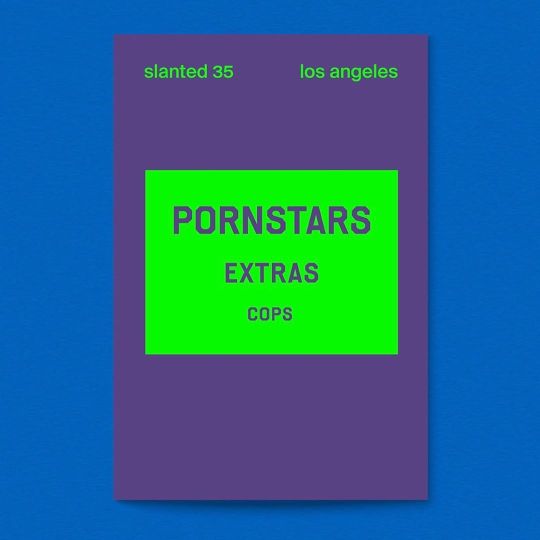
@siborg81 is kicking off @typographicsnyc today with "Resistance Made Visible" Check out Silas's work in Los Angeles (Slanted 35) Available at www.draw-down.com Featuring Mr. Keedy, Michael Worthington, Mark Kulakoff / BUCK, Lorraine Wild / Green Drago Office, Kali Nikitas, Jamal Gunn Becker, Karen To Nakada & Masato Nakada of Happening Studio, Gail Swanlund, Escher GuneWardena, Ella Gold, Benjamin Critton, Anne Burdick, Brian Roettinger, David Karwan, Jeremy Mickel / MCKL, Greg Lindy / Lux Typographic + Design, Jens Gehlhaar, Benjamin Woodlock / Abstract Office, Silas Munroe / Polymode, Raymundo T. Reynoso a.k.a. Eyeone, Alex Pines, Forest, and many more #typographics #typographics2020 #slantedmagazine #losangeles #SilasMunro #drawdownbooks #ResistanceMadeVisible (at Los Angeles, California) https://www.instagram.com/p/CDEkuxgHcM5/?igshid=ihx1i0vtaps9
#typographics#typographics2020#slantedmagazine#losangeles#silasmunro#drawdownbooks#resistancemadevisible
5 notes
·
View notes
Text
Benjamin Sack's impossible cityscapes
These are absolutely stunning! Piranesi meets Escher meets... reminds me of someone else I can't put my finger on.
"Over many years my interest in architecture and cityscapes has evolved." [These pieces have] "become a way and means of expressing the infinite, playing with perspective and exploring a range of histories, cultures, places."
His exhibit in Berlin runs until January 22 2020.
8 notes
·
View notes
Link
Dungeons & Dragons Starter Set by Wizards RPG Team
Clean Code by Robert C. Martin
How to Win Friends & Influence People by Dale Carnegie
Code: The Hidden Language of Computer Hardware and Software by Charles Petzold
Feeling Good: The New Mood Therapy by David D. Burns
No More Mr Nice Guy by Robert A. Glover
Introduction to Algorithms, 3rd Edition by Thomas H. Cormen
Starting Strength by Mark Rippetoe
Player’s Handbook (Dungeons & Dragons) by Wizards RPG Team
C Programming Language, 2nd Edition by Brian W. Kernighan, Dennis M. Ritchie
Thinking, Fast and Slow by Daniel Kahneman
JavaScript: The Good Parts by Douglas Crockford
Three Felonies A Day by Harvey Silverglate
Design Patterns by Erich Gamma
The Power of Habit by Charles Duhigg
Guns, Germs, and Steel by Jared M. Diamond
Code Complete by Steve McConnell
The Bogleheads’ Guide to Investing by Taylor Larimore
A Short History of Nearly Everything by Bill Bryson
The Pragmatic Programmer by Andrew Hunt, David Thomas
Cracking the Coding Interview by Gayle Laakmann McDowell
The Better Angels of Our Nature by Steven Pinker
The Demon Haunted World by
The Name of the Wind by Patrick Rothfuss
She Comes First by Ian Kerner
Head First Design Patterns: A Brain-Friendly Guide by Eric Freeman
The Martian: A Novel by Andy Weir
The New Jim Crow by Michelle Alexander
A Manual for Creating Atheists by Peter Boghossian
The Righteous Mind by Jonathan Haidt
The Lies of Locke Lamora by Scott Lynch
How to Prove It by Daniel J. Velleman
The Flavor Bible by Karen Page, Andrew Dornenburg
Models: Attract Women Through Honesty by Mark Manson
Ready Player One by Ernest Cline
Superintelligence: Paths, Dangers, Strategies by Nick Bostrom
Gödel, Escher, Bach: An Eternal Golden Braid by Douglas R. Hofstadter
C++ Primer (5th Edition) by Stanley B. Lippman
A Universe from Nothing by Lawrence M. Krauss
Batman Vol. 1: The Court of Owls (The New 52) by Scott Snyder
Influence: The Psychology of Persuasion, Revised Edition by Robert B. Cialdini
The Dialectical Behavior Therapy Skills Workbook by Matthew McKay
A Random Walk down Wall Street by Burton G. Malkiel
Drawing on the Right Side of the Brain by Betty Edwards
The 5 Love Languages by Gary Chapman
The Intelligent Investor by Benjamin Graham, Jason Zweig
Come as You Are by Emily Nagoski Ph.D.
A History of God by Karen Armstrong
The Art of Game Design by Jesse Schell
Red Rising by Pierce Brown
Time Management for System Administrators by Thomas A. Limoncelli
Lamb: The Gospel According to Biff, Christ’s Childhood Pal by Christopher Moore
Ender’s Game (The Ender Quintet) by Orson Scott Card
The Power of Now by Eckhart Tolle
The War of Art by Steven Pressfield
Learn Windows PowerShell in a Month of Lunches by Don Jones, Jeffery Hicks
The Millionaire Next Door by Thomas J. Stanley, William D. Danko
Mistborn: The Final Empire by Brandon Sanderson
Cracking the Coding Interview by Gayle Laakmann McDowell
Confessions of an Economic Hit Man by John Perkins
How to Lie with Statistics by Darrell Huff
Command and Control by Eric Schlosser
Waking Up: A Guide to Spirituality Without Religion by Sam Harris
Getting Things Done by David Allen
Working Effectively with Legacy Code by Michael Feathers
The World Of Ice And Fire by George R. R. Martin
Misquoting Jesus by Bart D. Ehrman
A Guide to the Good Life by William B. Irvine
Trump: The Art of the Deal by Donald J. Trump, Tony Schwartz
Head First Java, 2nd Edition by Kathy Sierra, Bert Bates
Effective Java (2nd Edition) by Joshua Bloch
Snow Crash by Neal Stephenson
Man’s Search for Meaning by Viktor E. Frankl
The Creature From Jekyll Island by G. Edward Griffin
The Mind Illuminated by Ph.D.) Culadasa (John Yates
Rise of the Warrior Cop by Radley Balko
Ready Player One: A Novel by Ernest Cline
The Life-Changing Magic of Tidying Up by Marie Kondō
Mindfulness in Plain English by Bhante Henepola Gunaratana
Manufacturing Consent by Edward S. Herman, Noam Chomsky
The Way of Kings (The Stormlight Archive) by Brandon Sanderson
Don’t Make Me Think, Revisited by Steve Krug
1491: New Revelations of the Americas Before Columbus by Charles C. Mann
Saga, Vol. 1 by Brian K Vaughan
The Practice of System and Network Administration, Second Edition by Thomas A. Limoncelli
A People’s History of The United States 1492- Present by Howard Zinn
Dune by Frank Herbert
The Lean Startup by Eric Ries
The Problem of Political Authority by Michael Huemer
The Baby Owner’s Manual by Louis Borgenicht M.D., Joe Borgenicht
House of Leaves by Mark Z. Danielewski
The Gift of Fear by Gavin de Becker
On Food and Cooking by Harold McGee
Sex at Dawn by Christopher Ryan, Cacilda Jetha
A Game of Thrones (A Song of Ice and Fire, Book 1) by George R.R. Martin
Old Man’s War by John Scalzi
The Devil in the White City by Erik Larson
Everyone Poops by Taro Gomi
What’s the Matter with Kansas? by Thomas Frank
Escape from Camp 14 by Blaine Harden
The Anxiety and Phobia Workbook by Edmund Bourne PhD
How to Read a Book by Mortimer J. Adler, Charles Van Doren
Ordinary Men by Christopher R. Browning
Elements of Style by William; White, E. B. Strunk
Why Evolution Is True by Jerry A. Coyne
Sapiens: A Brief History of Humankind by Yuval Noah Harari
On Killing by Dave Grossman
On the Historicity of Jesus by Richard Carrier
Mindset: The New Psychology of Success by Carol S. Dweck
What Every BODY is Saying by Joe Navarro, Marvin Karlins
HTML and CSS: Design and Build Websites by Jon Duckett
9 notes
·
View notes
Photo

Davos Masters - besser geht’s nicht
Das Davos Masters ist der Top-Golfanlass in sportiver Hinsicht. Mitglieder und Gäste erlebten einen perfekten Matta-Tag. Sonne pur und beste Platzverhältnisse waren ihre steten Begleiter – vom Start bis ins Ziel.
Kaum eine Sportart, die nicht von Gönnern mitgetragen wird. Das grosszügige Sponsoring der Davoser Mitglieder und Geschäftsleute sprengte beim Davos Masters gar deutlich den Rahmen gängigen Supports; namentlich waren das die Bianchi Platten AG, die Schneider’s, Escher Raumdesign, Ettinger Sport, Guyan Immobilien, Issler Sanitär, Kelly Transporte, Früchte Waser und die UBS Davos. Dem Erfolg dieses Events stand ebenso von der Seite nichts im Wege.
Die sportliche Note
Und exakt diese stand im Vordergrund. Die Organisatoren optimierten die Formel vom Vorjahr weiter. Der Bruttosieger wurde aus den 8 besten Damen und 12 besten Herren nach der ersten Runde im Modus Strokeplay über die Löcher 10 bis 14 erkoren. Damit der Zeitrahmen intakt blieb, entschied beim Start ins Turnier das Handicap. Die besten Spieler legten morgens um acht los. Nach 18 Löchern blickten die ersten Ankömmlinge mit Spannung auf das Leaderboard. Kurz nach zwei Uhr war der Neustart geplant. Doch aufgrund der potentiellen anderen Finalisten und des Wartens auf die besten acht Damen gab’s eine Verzögerung. Gleichzeitig bedingte es, dass die zuletzt Startenden über die ersten 9 Löcher ihr Spiel absolviert haben mussten. Mit einer Stunde Verspätung kamen die Finalisten zum Zug, und ihr tolles Spiel wurde von vielen Zuschauer auf den Bahnen 11 und 14 verfolgt. Im letzten Damenflight spielten Dascha Drobny, Sonja Müller, Celine Hügli und Barbara Lanter, bei den Herren die Gebrüder Remo und Marco Lang, Geoff Soguel und Benjamin Maier. Nun blieb die Frage: Wer hat die besten Nerven?
Sport und Genuss
Trotz grossgeschriebener Sportlichkeit, die diesen Anlass zu dem macht, was er ist, kam der Genuss nicht zu kurz. Die Teilnehmerin vom Golfclub Beuerberg (D), Fabienne-Loui Schachner, beteuerte fix, dass sie noch nie an einem Golfturnier so eine exquisite Zwischenverpflegung wie jene von Schneider’s serviert bekommen habe. Hoppla – dabei zählt just Beuerberg zu den Nobelclubs rund um München. Der zur Preisverteilung servierte «Apéro riche» im Clubhaus stellte schliesslich das i-Tüpfelchen dar. Unter dem Aspekt durften alle Teilnehmenden – ob nun im Finale dabei oder nicht – auf jeden Fall einen Golftag der Genüsse verbuchen.
Nervenstärke zum Schluss
Bei den Damen blieben die Überraschungen aus, denn Sonja Müller zeigte bereits auf der 18-Loch-Runde, dass sie in Hochform agierte. Sie gewann über die fünf Finallöcher zwei Schläge vor Barbara Lanter. Bei den Herren war der Gast aus Losone, Luigi Carioni, derjenige mit den stärksten Nerven; er galt nach den ersten 18 Löchern nicht als Topfavorit und konnte somit in aller Gelassenheit 20 Bruttopunkte erspielen. Benjamin Maier setzte sich dagegen netto an die Spitze, gefolgt von Michael Illi und Marco Lang. In der Kategorie Stableford, Hcp 19 bis 54, sorgte Rita Hofstetter für reges Aufsehen mit ihren 44 Stablefordpunkten, und zwar vor Gianna Casty mit deren 42. All diese Akteure konnten an diesem Tag ihr bestes Golfspiel abrufen.
Auszug aus der Rangliste:
Brutto über 5 Löcher: Damen: 1 Sonja Müller, 20; Herren: Luigi Carioni, 20.
Netto Hcp. Pro bis 18.9: 1 Benjamin Maier, 62; 2 Michael Illi, 64; 3 Marco Lang, 64. Netto Hcp. 19 bis 54: 1 Rita Hofstetter, 44; 2 Gianna Casty, 42; 3 Nico Zürcher, 34.
0 notes
Photo
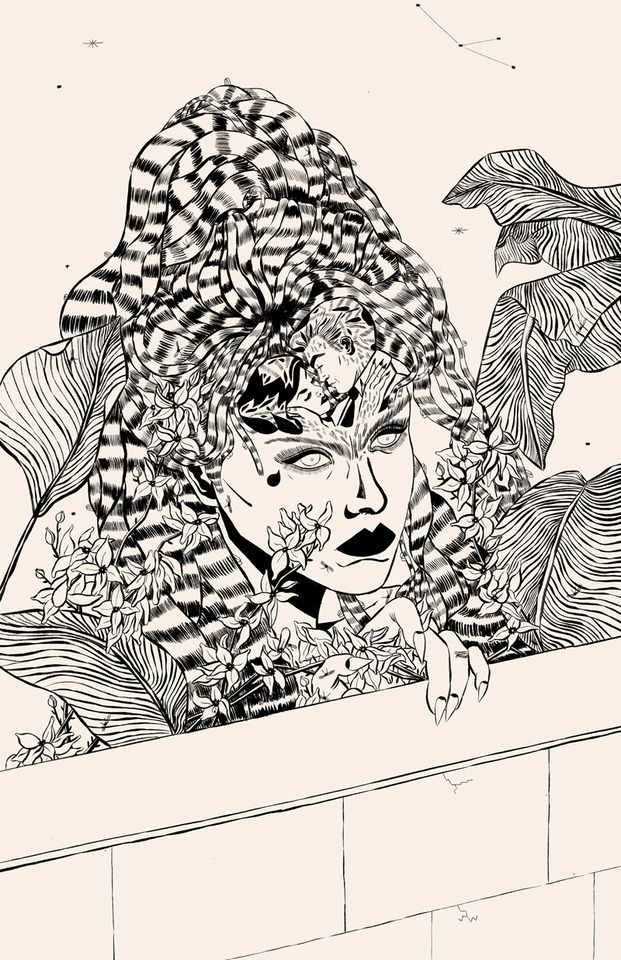
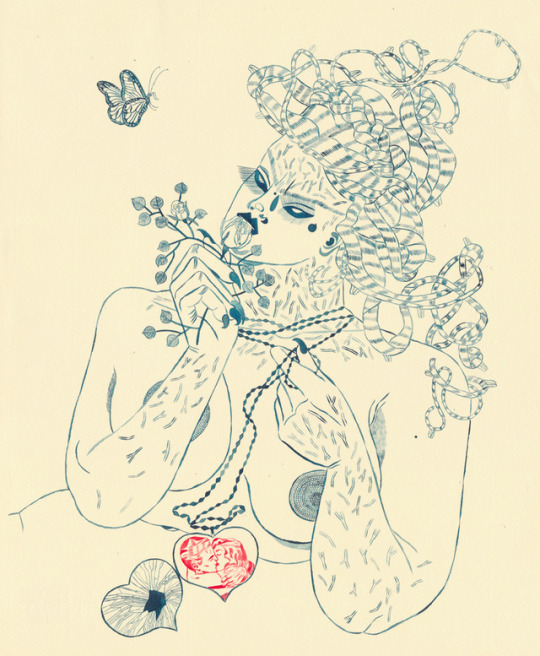
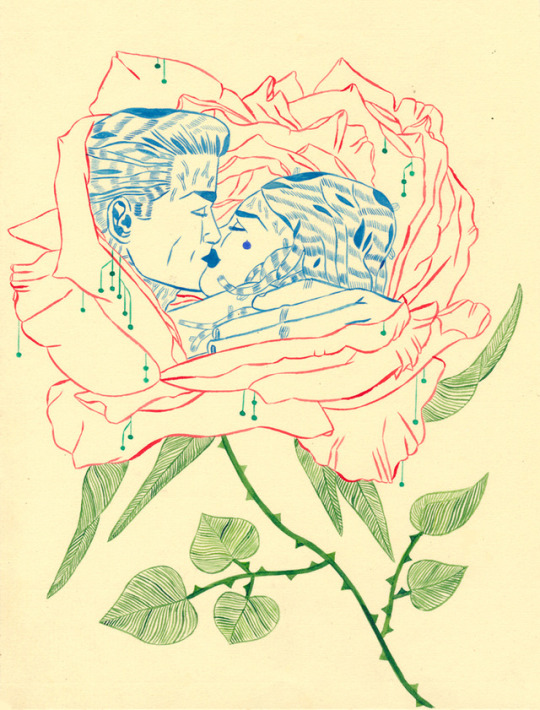
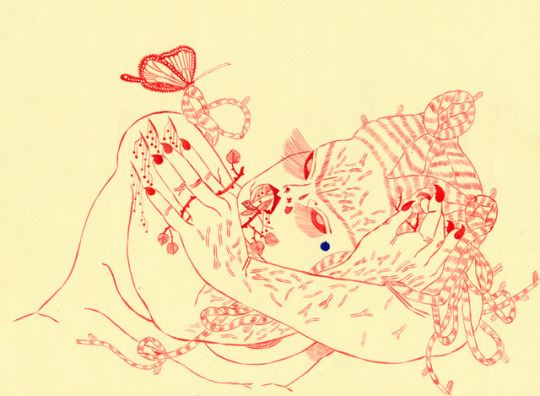
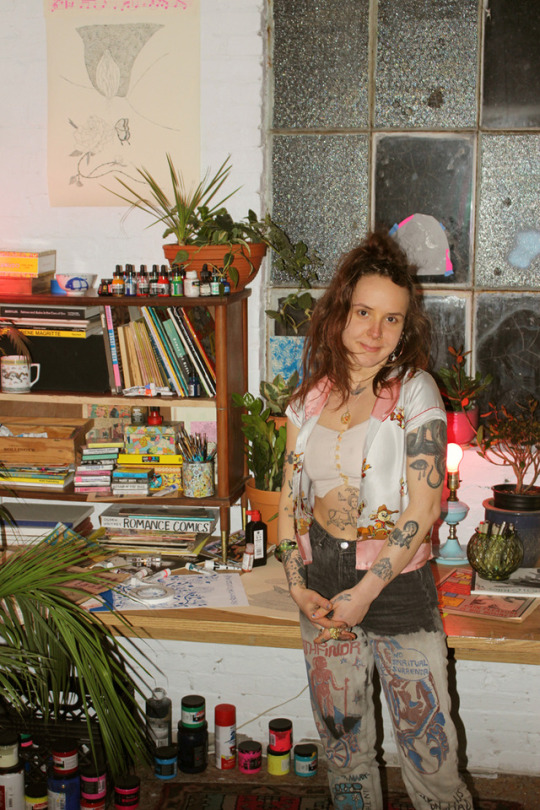

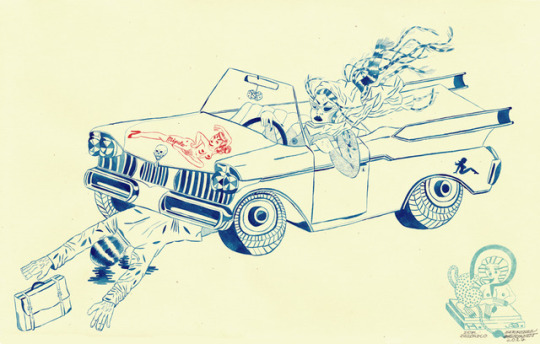
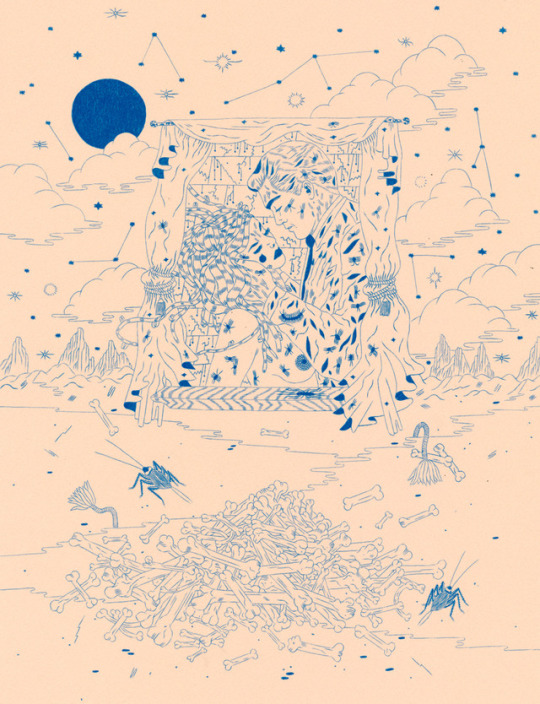
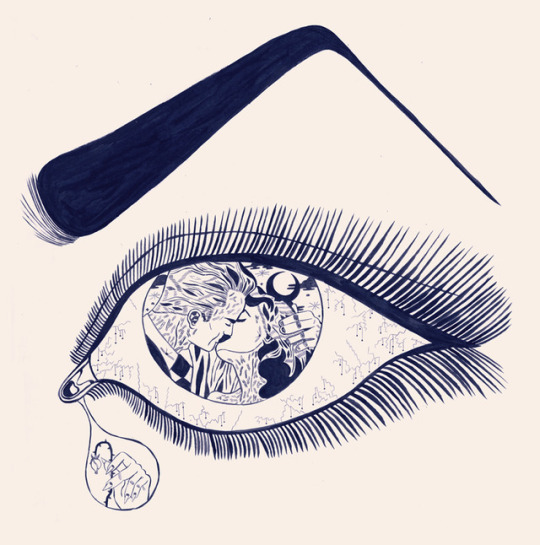

SKETCHY BEHAVIORS | Heather Benjamin (RH)
Through her dense and detailed packed line drawings to her more focused ink brush pieces, Rhode Island based artist Heather Benjamin’s work is visceral, cathartic, and autobiographical. It offers a completely unapologetic and unflinching look into an artists’ own struggles with life, body image, self confidence, and sexuality. We find her and her art to be inspirational, honest and badass.
We recently ran into Heather at her booth at the LA Art Book Fair and caught up with her a few months later to ask about her art, her experiences at RISD, her influences, and her thoughts about her work and her life.
Photographs courtesy of the artist.
Introduce yourself.
My name is Heather Benjamin, and I’ve been living in Providence, Rhode Island for the last few years.
Tell us a little about your drawing background? When did you first find yourself doodling?
It sounds corny, but I don’t remember a time when drawing wasn’t the thing I loved doing the most. I was like that as a little kid, as early as I can remember. I don’t have any concrete memories of being intentionally exposed to a lot of artwork as a child, but I definitely had a lot of visual stimuli from really early on - my dad papered my crib and the ceiling above it with M.C. Escher drawings and pages from Magic Eye books and similarly intense geometric patterns printed out from his computer, I think he read that it was good for babies to be looking at complicated visual stuff like that while your sight develops - and I feel really lucky to say that my parents were always really nurturing and encouraging of my interest in making artwork. They are both musicians, so even though neither of them had a background in visual arts, they were of a similar mindset and psyched that that’s what I was into.
What were your early drawings as a kid revolve around? When did you start to discover zines and printed matter?
The first artwork I got really, really obsessive about was Sailor Moon and Revolutionary Girl Utena, the original manga versions, when I was in fourth or fifth grade. I started drawing tons of fan art inspired by both of those, and from there eventually started developing my own imagery. I didn’t know about zines or weirdo/art comics until I was in high school, when my friends started to have cars, which made us all more mobile, and I was able to start going to punk shows and hanging out at DIY spaces and learning about places like art book stores and infoshops. I just didn’t know those things existed before that. The first zines I saw were all kind of anarchist zines, written about things like how to make your own tinctures and kombucha, telling stories about hitchhiking, or how to build your own screen printing setup.
So your first exposure to zines were mainly political or DIY style zines.
That was really my first exposure to seeing the book format/self-publishing being used as a way to disseminate information easily and cheaply, and I was really psyched on that. Then, when I went to Printed Matter for the first time - an art teacher recommended to me that I should check it out - I think I was around 16, was when I learned that people used self-publishing and the book format not just to spread anarchist or punk rock literature, but to bind together little books of drawings or prints or comics. And that’s around the same time I started finding out about the Fort Thunder scene of the 90s in Providence, and all the amazing zines and booklets and comics that came out of that, and came before that. All those things tied together were super influential and made me want to start making little books and zines of my own work.
When did you first find yourself making a zines and/or being deciding to self publish?
I made my first zines, the first two issues of Sad People Sex, when I was 18, as a freshman at RISD. I had interned at Printed Matter during my year off between high school and RISD, which was when I really was delving into the world of zines and self-publishing and art books for the first time, and I’d been wanting to release a zine of my own but just hadn’t made it happen yet. The first two issues of that zine were folded pieces of 8.5 x 11 white printer paper with photocopied black line drawings of people having sex and crying, that was my concept. No backgrounds or embellishment, just hairy people having sex and wearing socks and crying.
How did the idea for Sad People Sex become a zine?
I was going through a breakup, was feeling very teenage and depressed, and horny, but wasn’t getting any. I was wrestling having uncomfortably strong angry feelings towards my friends who were in relationships, just because they were in relationships, and then consistently getting into extremely masochistic and unhealthy situations with men myself. I was getting cynical about relationships and sexuality but simultaneously feeling hurt and wanting intimacy. So the drawings were basically me wrestling with those opposing feelings for the first time. As that series continued - I made ten issues from 2008 until I think 2012 - it stayed loosely around those ideas, but the drawings and treatment changed with the stages of my life and relationships I was going through. Towards the end of the Sad Sex series I had started making some other zines too that weren’t under that title, and when I decided to stop that series at the tenth issue, I kept going with other self-publishing projects, and I still do.
When did you decide that you wanted to attend an art school or even consider the idea?
In high school, I was constantly going back and forth between whether I wanted to go to a straight up art school, or go to a liberal arts college and major in English. I’ve always really enjoyed writing, and for a long time was super interested in Linguistics, I really thought that might be my, I don’t know, career path. I was confused enough that I took a year off after high school instead of going right to college, which honestly I think everyone should do. I didn’t feel like I figured too much out during that year as far as college and career paths, actually most of it was just spent really dicking around a lot and doing all kinds of bad kid stuff that I couldn’t pull off in high school, haha,
When did you decide to apply to RISD? And what was that experience like?
I guess I was “figuring out” some other stuff - but during that year I applied to colleges again, and decided to apply to RISD. I hadn’t applied there when I was a senior because I thought it seemed too straight-laced, I felt like, if I was going to go to art school then I didn’t love the idea of having to choose a major and stick to it, I wanted to be able to be more interdisciplinary than that seemed like it would allow me to be. But I opened up to the idea and applied and decided to go, half because everyone said it was “the best”, half because I had a super romanticized idea of Providence after being so influenced by and enamored with so much of the artwork that’s come out of Providence, some of my favorite artists ever. So I wanted to be a part of it and be around it. I had a weird rollercoaster of a time at RISD - my freshman year, I still don’t think I was ready to be in college.
What did you find that was super difficult for you at the time?
If I could go back and do it again, I probably would have taken another year off before starting school. I was really depressed and having a terrible time, in my personal life and in school. I wanted to drop out after that year, but I gave it another shot and stayed for my sophomore year. By the end of that year I was really miserable, in so many ways, so I left. I ended up moving to Brooklyn and stayed there for a little over four years, and basically spent all my time on my artwork, aside from working tons of random Craigslist odd-jobs to pay my rent - doing flower arrangements, figure modeling, catering, all across the board.
But you ended up returning, and finishing? And how was that experience different from your previous one?
I really didn’t think I would go back to school, especially back to RISD, but I guess you can never predict what’s going to happen in your life and how your mindset might change, cause by 2014, I was feeling stagnant in my work, and kind of wishing I could have what I by that point viewed as the luxury of being able to choose from tons of amazing classes, work with incredible and influential teachers, have group critiques, all the things I took for granted a lot of the time when I was in school before just started to seem like they would be really good for me. I guess basically it just felt like I was finally ready for school, because I felt this really strong desire to learn, in the specific format that being in school offers you. So I went back, which is one of the reasons I moved back up here a few years ago.
Were there other reasons as well?
The other reason was I didn’t totally want to be in Brooklyn anymore, I needed more space - physical and mental - and, this was a big reason, I couldn’t afford to live there anymore without having to work so many hours at a day job that I wasn’t able to work on my drawings as much as I wanted to, and that seemed like a huge waste, to not have a real workspace, barely be able to afford my room, and spend most of my time waiting tables, which I am truly terrible at, to pay for that tiny room. But in any case, I moved back up here and finished undergrad, and it was a funny experience because I was older than everyone in my classes and all my friends were gone, kind of felt like a ghost town to me in a weird way, but it was an amazing experience.
What do you think was the difference for you at RISD after a few years break?
Being in school when you actually really want to be there, and are soaking all the information and feedback up and just feeling inspired and challenged, feels so good. I’ve literally never had that feeling before; I think up until that point any time I’d ever been in school I just hated it. I even felt like, at the end of my most recent two years there, that I didn’t want it to stop! I was ready to keep going. It made me start thinking about grad school, another thing I never would have imagined I’d ever consider.
Who have been some of your early and persistent artistic influences?
In my year between high school and starting at RISD, I got totally obsessed with all the artwork that came out of the Fort Thunder scene in Providence in the 90s/2000s. And as a result of learning about some of those artists - Brian Chippendale, C.F., Mat Brinkman - I learned about and became interested in other artists who worked with them or were influenced by them, like the Paper Rad collective, as well as other artists involved in making weird art comics as a whole, like Gary Panter. Basically, finding out about the Fort Thunder scene, and subsequently doing research into the artists who grew tangentially out of that as well as those who influenced the people involved in it, opened up an entire world of influence for me - it was around the same time that I found out about and became obsessed with Raymond Pettibon, especially his older zines.
Oh the good stuff!
I found out about the now-defunct publishing house PictureBox when I realized that a lot of the formally released book projects from the Fort Thunder affiliated artists who I loved had been released by the same publisher, so I decided to look into the other artists that PictureBox had produced books or prints for, and found out about even more artists who ended up being influential to me just by looking through that catalog, like Frank Santoro, Julie Doucet, Charles Burns, King Terry. And at the same time, I was dipping further back into weird comics/art history and learning about R. Crumb, Aline Kominsky-Crumb, Wimmen’s Comix, and really the Last Gasp catalog as a whole.
How did all this research into the underground comics and artists of PictureBox influence you at RISD?
All these artists played a huge part in me beginning to make my own content in my late teens, when I was starting at RISD, and made me think about my linework and my content, as well as format and self-publishing, in different and super influential ways. I definitely would not be making the kind of things I make right now if I hadn’t followed this trajectory of finding out about all the artists and kind of work I just mentioned.
When did you start mainly working w/ pen and paper?
I’ve always been a compulsive doodler, I got in trouble for it in school and had issues studying for tests, because when I’d open up my binders, my notes from class were just completely covered in whatever I had been absent mindedly drawing. So I’ve always been really comfortable using pen and paper, I just gave myself so much inadvertent practice for years.
When did you go from compulsive doodler to kind of the work you do now?
I didn’t ever take that seriously as a medium until I was in college, though. I made my first zine, Sad People Sex, when I was a freshman at RISD, I was 18. I drew it with Micron pens on printer paper and photocopied it. I think the main reason I used pen to do it was not just because I was comfortable with it, but because I knew it would photocopy well, which was important. The original drawings didn’t even really mean anything to me, it was all about how the zine would look once the images were reproduced. I’ve had that mindset for a long time now, making things only with the intention of them being reproduced in some way, and have only recently started to try to open up a little more out of that, and make some work that’s meant to exist only in it’s original form, not made to be reproduced to the point where the original is almost inconsequential.
Why were pens your favorite medium, you think?
For years I was so into using tiny pens for everything, because I loved getting hyper detailed in my work. I still do, but in the last few years I’ve been moving away from using pens, and have instead been trying to teach myself to get the same level of detail using a brush and ink instead. I’ve always loved painting and have been trying to move more in that direction - for so long, I worked in a pretty traditional “cartoonist” style, pencilling things out on bristol board and then inking them with pens, then going back in and erasing the pencil. I got really tired of that - it really is only good for something that’s going to be reproduced in some way, printed or scanned, because the originals end up getting really smudgy, the erasers pick up so much of the ink as you go back over it - it has it’s own charm, it’s it’s own thing, but not what I’m doing now.
Interesting, so you moved away from the hyper detailed drawings?
More recently, over the last year, I have been really enjoying challenging myself by not only moving into just using brush and ink instead of a pen, but also not pencilling anything, so eliminating the steps of doing a lot of planning things out in pencil and then a lot of erasing after the inking is done. I guess it’s more of a painterly thing - I’ll make a really quick pencil “study” in my sketchbook, just a vague outline of what I want to make, and then go straight to a larger sheet of nice paper, directly with brush and ink.
How do you think this process of brush and ink compares to your “tiny pens”?
It makes me work slower, think more deliberately about each line in the moment, because it’s so unforgiving. And it also somewhat decreased the element of total control in my work, which feels hard for me, but good. If a weird proportion or line happens, then it happens. I can’t just erase it and draw it again until it’s perfect like I used to. I’ve also become so attached to the fluctuations in line weight that happen naturally when using a brush, to the point where the uniform thickness of a 005 or 01 Micron or Prismacolor pen seems boring to me a lot of the time now! That said, I will never totally move away from using pens, they’re great for certain things, and I totally still doodle with them in my sketchbook and on all the scrap paper I have lying around the studio. But I am more all about using brushes these days.
There’s an energy to your work and compositions that exudes an endless and obsessive creative energy. Some of your work is almost entirely covered and packed with details, textures and background. Were you always drawing this way or was it something that developed for you?
This is something that has changed a lot for me over the last five or six years. For a while, I was totally obsessed with making super detailed and dense work, there was almost no open space left on the page ever, and that was how I liked it. Then, I felt like I went through a period where I was upset with that, and I wanted there to be more compositional balance in my work, leave some open areas that felt like they were supposed to be open, but I couldn’t figure out how to do it and just by default would end up filling every inch with linework, then I’d sit back and look at the piece and be so angry with myself for being so stuck in that loop. I guess to some extent I’m still struggling with that!
It’s pretty amazing how much you packed in your pieces. Why do you think you were making such such detailed drawings and compositions?
These days, I don’t enjoy having quite as dense of compositions as I used to, but I do still love detail. I guess I’m still working it out. But I can say, during the time when my work was the most dense - like the middle of the Sad Sex zine series, around issues 6/7/8 where every single inch is just covered in linework - that was a period of time where I was doing so badly mentally, felt completely manic, was taking tons of adderall, and spent all my time alone in my room drawing. I would sit at my desk for 14 or 15 hours a lot of the time, only taking breaks to go to the bathroom, chainsmoking at my desk and working on those drawings.
In retrospect I can see the density and manic quality to those drawings as a reflection of my mental state at the time. I gave myself carpal tunnel from how long I used to sit and just work without any breaks at all. I lost tons of weight, wasn’t eating, just coffee and cigarettes and adderall. It was so bad! I have a completely addictive personality and that was the worst it has ever been. My process now is totally different - I will still work for hours, but not 14. Usually the most time I’ll spend consecutively in studio is 8 or 9 hours. And I don’t take adderall anymore, haha. That was.. not good. I went through kind of an enormous lifestyle upheaval after that period of time, like four years ago, and my style of working changed along with it, since the two are so tied together for me.
How has your process changed now for the better?
My process now is basically that I’ll make vague little pencil sketches in my notebooks for ideas for pieces, and then once I get into studio, I’ll cut a big piece of paper - I’ve been just using this one kind of paper lately, a nice off-white shade of Ingres - and just go straight at it with brush and ink. I love, love, love this way of working. It feels super meditative and precise and slow and fulfilling. I end up with way less finished pieces that I like, because they’re so unforgiving, and I work much more slowly than I used to because of how much more time I’m spending figuring out my next move, but I like it so much better this way. Even though I’m working slower, though, I still can’t sit with an unfinished piece for more than about a week. If something’s hanging on my wall unfinished for more than like, six or seven days, I definitely lose interest in it. It’s hard for me to go back into things that aren’t at least somewhat fresh.
You make some powerful images and fairly graphic ones too, involving pleasure and pain, the body, and/or involving predominantly a female character who is not to be messed up. Your process and art has an intimate and very personal aspect – how autobiographical is it?
My work is very, very autobiographical. I love when people relate to my work, there’s basically nothing more fulfilling than someone having a very visceral and personal reaction to something that I drew. But the reason for that is because when those connections happen, they make me feel less isolated! My work is so diaristic, everything I draw is coming from something I’m personally feeling or thinking, I’m not trying to speak for anyone else. Even though I think sometimes this ends up happening, I’m never really intentionally trying to make work that speaks to women’s experiences a whole. I just think that’s too lofty and assumptive of a goal. I’m expressing my own experience, and when it does align with other peoples’ and they tell me that, it feels amazing, that’s huge for me. But it is all totally autobiographical.
What type of personal issues do you find you are addressing in your work?
I’ve always had a very complicated relationship with my self confidence, my perception of myself, my body image. Almost my whole life I’ve felt like I just bounce between the two extremes of feeling totally confident and proud and beautiful, sometimes to a point where I worry that it’s egomaniacal, and then feeling like total fucking shit, so disgusting, hating my body and my mind. Obsessive compulsive, body dysmorphic, manic and embarrassed or livid and insane. Then add a heaping dose of the yin/yang thing that happens where, in the realm of seeing myself as a sexual being, I’m ricocheting between shame and trauma, and joyous or animalistic raw sexuality - actually, not usually ricocheting, it’s kind of just always both at the same time. It’s super confusing, it’s overwhelming, and I constantly feel bogged down by it all. I don’t feel like I”m good at putting this into words - one of the reasons why I make work about it. It’s a better way for me to articulate how I feel, the bouncing back and forth between extremes or the coexistence of all those opposing feelings at the same time.
Sounds like making art and the process of making art helped you immensely?
And the process of making work about those feelings is cathartic to me - aside from things like, doing breathing exercises or yoga, it’s basically the only thing that centers me. Because the giant swirling mess of all those mixed up and messed up feelings is always roaring in my head and causing all kinds of unintended and stressful consequences, and I can never completely make sense of it. But being able to take a big handful of those feelings, translate them into some symbols and imagery that make sense to me, and turn it into a picture that, even if it contains graphic or lewd or unsightly content, is hopefully, when you step back and look at it, a beautiful picture, that’s my way of making sense of it. Maybe it’s hard for me to really take a step back in my life and in my mind and tame all the beasts, but if I can articulate it all into pictures and physically take a step back and see it all at once forming a narrative that way, and creating something pleasurable out of all the crazy or shitty or confusing pieces, even if it’s just aesthetic valueand feel other people relate to it too, that helps me.
You mentioned that you often keep a sketchbook. Some artists keep sketchbooks and some don’t. What about it do you find helpful?
I keep a sketchbook, which I think is really important for me. I just jot down ideas in there when they hit me, or write down things I want to check out later, whatever I just need to make a note of. And do quick little super vague drawings of things that maybe would end up in a finished piece.
When I go into the studio, I either know what I want to work on - in which case I work from the quick pencil drawings or studies that I have, and just go straight to brush and ink on paper using them for reference - or if I’m not sure where I’m going yet, I’ll look through my sketchbook to try to piece together a few ideas, or look at some of my books, or at stuff on the internet for some inspiration for a jumping off point.
Where do you find inspiration if you’re feeling “uninspired”?
I try not to look at the internet too much for content or inspiration, but when I do, I usually look at one of a few blogs that I follow on blogspot where people post Pre-Raphaelite paintings and drawings, or a couple that I follow who are like, old dudes in the midwest that collect weird old printed ephemera and photographs of belly dancers and porno magazines that they scan and share. But if I’m working from reference, I really prefer working from printed materials that I have on hand. I collect a lot of old magazines, like old playboys or gardening catalogs and romance comics that I find at flea markets and antiques malls. Usually if I’m feeling a block, I’ll pick up one of those and use it as a jump off to start doodling, then close it and keep going with the drawing myself. That usually helps! If it doesn’t, and I’m having one of those days where everything just looks like shit, I try not to beat myself up too much, and go expend the creative energy elsewhere, like sewing or cooking, so I don’t end up feeling completely pent up. I definitely have a complex, or something, where I am super self-critical if I’m not productive every single day. I get really mad at myself if it “just isn’t working” in the studio, so the least I can do is try to spend that energy on another project, even if it isn’t art related, just so I don’t lose my mind.
I recently ran into you at the LA Zine art book fair. How was that event for you? What do you love about a zine fest? Anything you picked up you’d recommend?
LAABF was amazing! I’ve never been to LA before, so that was huge. So many people I know have been moving there over the last few years, and I didn’t really get why, since I hadn’t been there. All it took was going there for a week to get it, haha. I really get it now, I loved it there. Aside from being psyched on being there, the book fair itself was awesome. I’ve been tabling at the NY art book fair, which is basically the exact same event but at P.S. 1 in New York, every year since 2010, but I could never make it out to the LA fair. I was always either too broke, or in school. Or both. But I could finally swing it this year, and I’m so glad I did. There were a lot of the same exhibitors as there are in New York, and there were a ton of new ones too, people who don’t make it out to the New York one, so that was great. And even with the people who table at the NY fair as well, everyone always puts out new publications and editions to debut at the fair, so it’s just an amazing environment of everyone showing each other all their new work, tons of creative energy and enthusiasm. I’ve tabled at a lot of zine and comics fairs, but the Printed Matter book fairs are always the most exciting, by far.
Could you describe your current surroundings and/or studio? Do you have a favorite object in that collection?
I just moved into a new studio in the last month and I’m so psyched on it. It’s by far the nicest, and biggest, workspace I’ve had. It’s a little standalone building, actually a converted garage for the house I live in, that’s in my backyard. It’s got a bunch of big windows and a woodburning stove, it feels very New England which I love, ha! I’m still setting it up, but I’m in love with it. My last two studios were much smaller, and even though the rooms themselves were private, they were in buildings that were shared with a ton of people, so it was always noisy. Especially my last studio, which was in a warehouse building where a lot of bands in town have practice spaces. I think I was the only person renting space in there that wasn’t a band or someone using really loud machinery. I never really got completely used to that, so having this completely isolated, private, quiet space feels so luxurious now. I’m so into it. My favorite thing in here is probably my collection of old romance comics. I’ve loved the aesthetic of these for years now, but only started sort of collecting them in the last year or two. I don’t buy them online or anything, I just wait to come across them at flea markets or antiques malls, so the collection is growing slowly, but I kind of like it better that way. I know I could find a bunch of amazing issues pretty easily on the internet, but I like collecting the ones that just make their way to me. I use them a lot for reference for my drawings, but also just love reading them and having them around.
What are your top 5 artists at the moment?
Paul Delvaux, Leonor Fini, Rossetti, Pettibon, Virgil Finlay
Favorite Vans?
Definitely my first pair ever which were the red and white checkered slip ons. I finally convinced my mom to let me get them in seventh grade. I wanted them so bad, I think she just thought they were too crazy, but she finally gave in. And I got them just in time to wear them to Warped Tour in Asbury Park. I can’t remember what year that would have been.. maybe 2000? or 2001? All I know is I was wearing my red and white checkered vans and tons of rubber bracelets and watching Rancid play for the first time and in that moment I could have died happy.
In a parallel dimension, what would you be doing (job wise) if you weren’t an artist?
Probably teaching! Which is still something I hope to do, I’d like to be an art teacher to little kids, I’ve done a little volunteer work in that area. We’ll see how that goes, I might have already put the nail in the coffin of that dream when I started posting drawings of swollen bleeding vaginas on the internet. But maybe I’d be teaching something else, like English or Feminist Literature or Linguistics.
Ask and answer a question you never get asked.
(I am totally stumped on this one but will let you know if i come up with something, hopefully I will!!)
What’s the best advice you’d give someone struggling with his or her art?
Keep a sketchbook and draw something in it every day even if you hate how it comes out. Look at tons of other peoples’ art, new and old. And not just on the internet; buy art books. Ones that have writing in them, about the artists’ process, essays, and read them. Buy them used, it’s cheap! Soak up tons of information, think about it and react to it. And be hard on yourself, but don’t be unhealthy about it. You have to take care of yourself. Now I just feel like I’m talking to myself here, haha!
What do you have coming up for 2017?
I’m doing a residency in Brooklyn for the month of September, and tabling at the NY art book fair this Fall. I have a few group shows lined up through the end of the year, too. Aside from that, I’m really focused on trying to make a new body of work, and larger paintings, and hopefully find somewhere to show them early next year!
Follow Heather
Website: baby-fat.net
Website Store heatherbenjamin.bigcartel.commy
Instagram @heatherbenjamin_
766 notes
·
View notes
Text
Hey guys … it’s the weekend!!! And better yet, spring is finally here … well, sort of. My crocuses are in bloom, though there are only four of them, Maha’s daffodils are blooming, and I was outside for a few minutes today in a t-shirt and didn’t even feel cold!

I am not an artistically talented person, as I’ve mentioned before, but I admire those who are. I’ve concluded, though, that some people have entirely too much time on their hands. Legos. Remember building stuff with Lego bricks? I could build a fence, or a small house (no windows, doors or roof, though). But take a look at the artistic endeavours some have accomplished with those little plastic blocks …

Full-size Lego giraffe


Probably just as safe as a Boeing

The Beatles in Legoland

This cruise ship is 8.44 meters long, 1.33 meters wide and 1.54 meters high, and is made from more than 2.5 million LEGOs. The weight of it is also quite stunning because it weighs around 2 tons, that is, about 6,100 pounds!
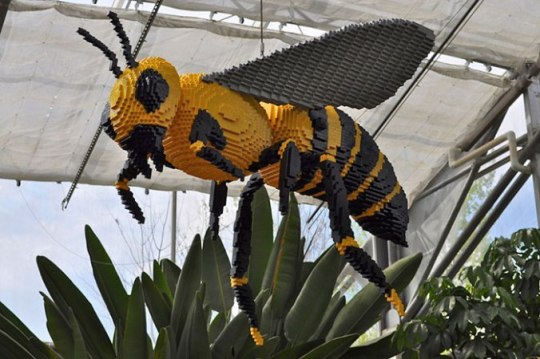

They even re-create classical paintings and sculptures with Lego …

Escher’s Relativity
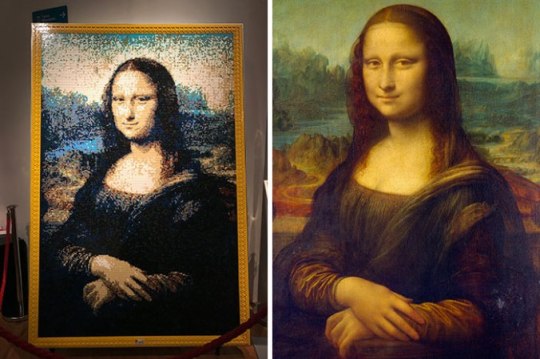
Da Vinci’s Mona Lisa

Mount Rushmore
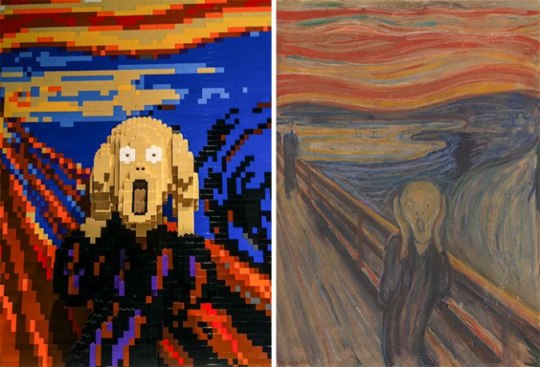
Munch’s The Scream

Rodin’s The Thinker
Talented? For sure, but I still have to ask … who has time to do these things? There are plenty more if you’d like to check them out at Bored Panda!
Now, when you think of squirrel, what do you think of? Grey, brown, muted colours, right? But I bet you didn’ know about the Malabar giant squirrel, also known as Shekru. These guys are native to India … take a look …

As the name suggests, they are huge. Stretching as long as 3 feet, they are much harder to miss than our own scurrilous buddies. Admittedly though, the brilliantly blue bushy tail accounts for much of the Malabar’s length.

However, they may be more difficult to find than their large size and bright coat suggest. The shades of black, brown and orange, as well as maroon and purple, can assist them in blending perfectly with the forest canopy, where they spend their time leaping from tree to tree. This is especially useful for escaping the attention of predators, such as various birds of prey and also leopards.


Did you know that there is an entire town for sale in Indiana? No? It’s the town of Story, Indiana, and there is a … wait for it … story to go with the town!
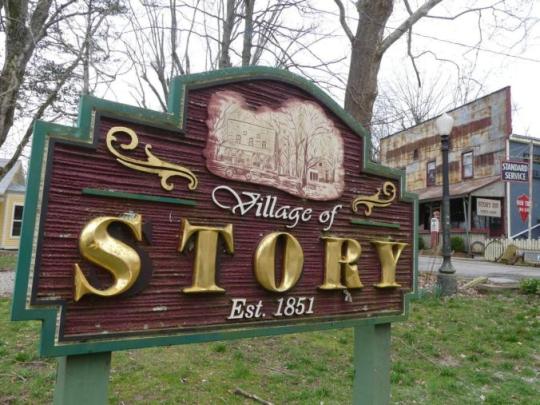
The town began in 1851, when a doctor named George P. Story received 173 acres of land from Millard Fillmore, 13th president of the United States. Over the years, the town then known as “Storyville” started to grow—farms, Story’s medical practice, and a school. In 1882, Story got its first dry goods store and post office. It never grew particularly large, but the story goes that the Great Depression cleared out what few families were left, threatening to end Story and turn it into a ghost town.More or less abandoned to the elements, Story saw a small resurgence in the early 1980s. Benjamin (who goes by just one name) encountered the town—on the edge of Brown County State Park and not far from Bloomington—for the first time in 1978. He saw the old general store, a house, a gristmill, a barn, and “an assortment of mostly dilapidated buildings,” on four and a half acres and for sale for $65,000. He and his wife Cyndi took a chance on the unique town and decided to set up shop in the form of a restaurant, housed in the old general store. “[It] had no indoor plumbing when we moved there, only an outhouse in back,” he says. The second floor was one large room. “Many years previous, owners had obtained a Studebaker franchise and assembled buggies up there,” Benjamin says. “Parts were sent by rail from South Bend to Freetown, brought to Story on horse-drawn carts and first-generation pickup trucks, hauled upstairs, and assembled. The final products were let down on a ramp through a door in the back.” He remembers Story being very dark, and very quiet.

Benjamin’s restaurant
There are only six houses in Story. One of them, built in the Queen Anne style, is the Wheeler-Hedrick House, across the street from the store. Another, built in 1858, is known as the Story-Griffitt House. Benjamin and Cyndi bought them all, one at a time, and converted them into overnight accommodations—the Story Inn. “We also built a commercial kitchen in the back [and] the old general store became the dining room,” Benjamin says. “When we sold Story we had a 100-seat restaurant and 18 overnight rooms, all on 23 acres.”

The town’s current owner, Rick Hofstetter, bought the town in 1999. Hofstetter put more effort into Story, and the 40 years of care has turned into a fairly popular—though out-of-the-way—tourist destination. While most of Story’s buildings have been renovated, the village has not lost its 19th-century charm. Because it was a relatively desolate (and poor) town for decades, its original historic wooden floors, globe lighting, and tin ceilings remain. Just last month, the town was officially listed on the National Register of Historic Places.
Today all of Story can be yours, for only $3.8 million! Hey, if all my readers kicked in a mere $1,396 each, we could go in together and have our own little town!
Well, folks, I know you have a weekend awaiting you … I hope you have a great one and do something fun!

Saturday Surprise — Legos ‘n Squirrels ‘n A Town For Sale Hey guys … it’s the weekend!!! And better yet, spring is finally here … well, sort of.
#Escher#George P. Story#ghost town#Lego creations#Malabar giant squirrel#Mona Lisa#Mount Rushmore#Story Indiana#The Scream
0 notes
Text
Picture This: Baseball Advertising Hits it Out of the Park
Baseball Advertising Hits it Out of the Park
By Kristi Finefield
The following is a guest post by Jan Grenci, Reference Specialist for Posters in the Prints and Photographs Division – as well as a long-suffering Pittsburgh Pirates fan.
For almost as long as the game has been played, baseball imagery has been used to advertise a wide variety of products. These items from the Prints and Photographs Division are in a league of their own!
Would the well-dressed fan be grandstanding if he or she wore these hat bands and collars to a game?
The Wick Fancy Hat Bands. Cheer up – Show your Colors. Poster (chromolithograph), c1910. https://ift.tt/29w36JT
The Base Ball Collar. Lithograph copyrighted by Stiefel & Co., c1869. https://ift.tt/1U77r3D
No one would be caught flat-footed if they were polkaing to these tunes:
Home run polka. Composed by Mrs. Bodell of Washington, and respectfully dedicated to the National Baseball Club of Washington, D.C. Lithograph by L. N. Rosenthal, 1867. https://ift.tt/2PfZzR4
Base Ball Polka. Lithograph published by C.F. Escher, 1867. https://ift.tt/2ODpVvc
From out of left field come these ads for pest extermination:
“Sure Catch” sticky fly paper. Chromolithograph, between 1853 and 1898. https://ift.tt/2vPHFwq
Use Getz cockroach and bed bug exterminators, sold by all druggists. Chromolithograph, between 1870 and 1890. https://ift.tt/2KXwSoA
And finally, these two posters advertising the game itself cover all the bases:
[Stock poster showing runner sliding past catcher] Chromolithograph by Strobridge Lith. Co., c1897. https://ift.tt/2vNzYqD
Biddefords vs. Portlands Granite St. grounds, Biddeford, Friday, May 22. Lithograph and letterpress print published by John B. Sage, 1885. https://ift.tt/2KXwoyM
Ultimately, I don’t know if any of these ads were a hit or if they struck out with consumers, but they sure are fun to look at!
Learn More:
Explore prints related to baseball in the Popular Graphic Arts Collection in the Prints and Photographs Online Catalog.
View over 2,000 early baseball cards, dating from 1887 to 1914, in the fully digitized Benjamin K. Edwards Collection. Read more about the background and scope of the collection.
Explore the online components of the Library of Congress exhibit: Baseball Americana. The exhibit will be on display in the Thomas Jefferson Building of the Library of Congress until Summer 2019.
Published August 16, 2018 at 10:32AM
Read more on https://loc.gov
0 notes
Text
January 08 in Music History
1663 Italian composer and organist at Santa Maria Maggiore, Bergamo, Giovanni Legrenzi (1626-1690); published his third book of sonatas in Venice.
1668 Birth of French composer Jean Gilles in Tarascon.
1685 FP of Lully's opera Roland at Versailles.
1705 FP of Handel's first opera Almira in Hamburg.
1713 Death of Italian composer and violinist Arcangelo Corelli in Rome
1735 FP of Handel's opera Ariodante in London.
1735 FP of Pergolesi's opera L'Olimpiade, with libretto by Metastasio, at the Teatro Tordinona in Rome.
1788 Birth of Archduke Rudolph, Austrian amateur musician and music patron, Beethoven's friend and pupil. Youngest son of Emperor Leopold II and youngest brother of Emperor Franz, was Beethoven's greatest patron. Fidelio dedicated to him as well as Emporer concerto and Archduke Trio.
1792 Birth of American organist, composer and conductor Lowell Mason, in Medfield MA,
1812 Birth of Swiss composer and pianist Sigismond Thalberg in Pâquis.
1822 Birth of Italian composer and cellist Alfredo Piatti in Borgo Canale.
1830 Birth of German pianist, conductor, musical writer and first husband of Cosima Liszt Wagner, Hans Von Bulow in Dresden, Germany.
1831 Death of Moravian-born composer and violinist Franz Krommer in Vienna.
1840 Birth of Austrian soprano Antonietta Fricci in Vienna.
1843 FP of Schumann's Piano Quintet. Clara Schumann was pianist at Leipzig Gewandhaus.
1846 Birth of American composer William Wallace Gilchrist.
1852 Birth of French composer Gabriel Prosper Marie in Paris.
1854 Birth of soprano Adele Isaac in Calais.
1870 Birth of American mezzo-soprano Mme Charles Cahier in Nashville.
1880 Birth of Austrian soprano Melanie Kurt in Vienna.
1883 Birth of German tenor Waino Sola in Berlin.
1887 Birth of bass-baritone Benno Ziegler in Munich.
1890 Death of Italian baritone Giorgio Ronconi.
1892 Birth of Dutch cellist and conductor Hans Kindler in Rotterdam, Holland.
1895 FP of Johaness Brahms' Clarinet Sonata, Op. 120, no. 1 with clarinetist Richard Mühlfeld, Brahms at the piano, in Vienna.
1896 Birth of Czech composer Jaromir Weinberger in Prague.
1905 Birth of Italian composer Giacinto Scelsi, in La Spezia.
1906 Pianist Arthur Rubinstein makes debut at Carnegie Hall in NYC.
1911 FP of Florent Schmitt's orchestral work La tragédie de Salomé, in Paris.
1912 Birth of Dutch composer Rudolf Escher in Amsterdam.
1914 Birth of American composer Charles Borromeo Mills.
1915 Birth of bass-baritone Karl Donch in Hagen.
1922 Birth of American pianist Abby Simon in NYC.
1923 Birth of American bass Giorgio Tozzi in Chicago.
1923 First broadcast of an opera direct from a concert hall when the BBC broadcasts Mozart's The Magic Flute in London.
1924 Birth of Russian American composer Benjamin Lees in Harbin, Manchuria.
1924 Birth in Vienna of composer Robert Starter in Vienna.
1925 Birth of baritone Norman Foster.
1925 Russian composer Igor Stravinsky's American debut conducting the NY Philahrmonic in a concert of his works.
1926 Birth of soprano Evelyn Lear in Brooklyn, NY.
1927 Birth of Italian baritone Mario Zanasi in Bologna.
1927 FP of Alban Berg's Lyric Suite for string quartet by the Kolisch Quartet in Vienna.
1928 FP of Paul Hindemith's Kammermusik No. 7, Op. 46, no. 2. Ludwig Rottenberg conducting and Reinhold Merten, organist in Frankurt.
1932 Birth of baritone Bruno Tomaselli in Buenos Aires.
1937 Birth of American composer Robert Moran, in Denver, CO.
1937 FP of Arnold Schoenberg's String Quartet No.4 Kolisch Quartet, in Los Angeles, CA
1938 Birth of Russian bass Evgeny Nesterenko in Moscow.
1940 FP of Roger Sessions' Violin Concerto. Illinois Symphony conducted by Izler Solomon, Robert Gross was soloist.
1942 Death of Norwegian composer Catharinus Elling in Oslo.
1943 Birth of American composer James Marshall.
1946 Birth of Australian opera producer Elijah Moshinsky.
1948 Death of Austrian-English tenor and composer Richard Tauber in London
1950 Death of baritone Hilbert Vavra.
1951 Birth of American composer Paul Dresher.
1952 Birth of Russian pianist Vladimir Feltsman in Moscow.
1956 Birth of American composer Pierre Schroeder.
1957 Birth of American composer David Lang.
1963 FP of second version of Dmitri Shostakovich's opera Lady Macbeth of the Mtsensk District at the Stanislavsky-Nemirovich-Dachenko Music Theater in Moscow.
1964 Birth of American composer Robert Maggio in NJ.
1970 Birth of American composer Alan Frederick Shockley.
1971 FP of D. Shostakovich's Symphony No. 15. All-Union Radio and Television Symphony, the composer's son, Maxim, conducting in Moscow.
1975 Death of opera star Richard Tucker on a tour in Michigan.
1976 Death of baritone George Baker.
1987 Death of Spanish composer Manuel Blancafort in Barcelona.
1987 FP of Christopher Rouse's Phaethon. Philadelphia Orchestra, Riccardo Muti conducting.
1988 FP of Joseph Schwantner's Fantasy for Guitar and Orchestra, From Afar... Guitarist Sharon Isbin with the St. Louis Symphony, Leonard Slatkin conducting.
1998 Death of British composer Sir Michael Tippett at his south London home at 93 years.
2004 Postponment of FP of Oliver Knussen's Cleveland Pictures. In a Cleveland Plain Dealer article the Cleveland Orchestra's, Franz Welser-MÖst, conductor, says they hope to do it in the 2004-05 season. The composer was unable to finish the final movement in time for rehearsals. The Lutoslawski Symphony No. 4 will be moved from next weeks program for performance on this program which also features the R. Strauss Horn Concerto No. 1 with Richard King on horn and Beethoven's Symphony No. 2. 8 p.m. Severance Hall, 11001 Euclid Ave., Cleveland, OH.
2004 FP of Stephen Jones' at the exactest point by the Chicago Symphony. Jones is the dean of the College of Fine Arts and Communications at Brigham Young University. Conducted by Sir Andrew Davis, music director of the Chicago Lyric Opera. Also on the program Prokofiev's Suite from Cinderella and Rachmaninoff's Piano Concerto No. 3 featuring pianist Louis Lortie, at the Chicago Symphony Center.
2012 Death of Bulgarian pianist Alexis Alexis Weissenberg.
1 note
·
View note
Text
Necrologia do dia 07 de fevereiro de 2020 em Piracicaba e região
Grupo Unidas
Judith Correr Forti
Faleceu ontem, nesta cidade, contava 90 anos, filha dos finados Sr. João Correr e da Sra. Anna Forti Correr, era viúva do Sr. Henrique Forti, deixa os filhos: Maria Evanira Forti, viúva do Sr. Antonio List; Jose Estevão Forti, casado com a Sra. Claudete Christofoletti Forti; Beatriz Maria Forti Stenico, viúva do Sr. Jose Airton Stenico; Maria Terezinha Forti, casada com o Sr. Evaristo Stenico; Daniel Jose Forti, casado com a Sra. Sueli Maria Correr Forti; Jose Reinaldo Forti, casado com a Sra. Marisa Stenico Forti; Genésio Jose Forti, casado com a Sra. Neide Maria Christofoletti Forti; Maria Assunta Forti Stenico, casada com o Sr. Lino Stenico; Claudinei Jose Forti, casado com a Sra. Rosangela Maria Forti e Jose Eugenio Forti. Deixa netos, bisnetos, demais parentes e amigos.
Seu sepultamento será realizado hoje, saindo o féretro às 09h do Domicílio da Família, sito a Rua Samuel Forti, 45 – Santa Olímpia, para o Cemitério Parque da Ressurreição em jazigo da família.
Professor: Antonio Jose Tavares
Faleceu ontem, nesta cidade, contava 78 anos, filho dos finados Sr. Severiano Tavares e da Sra. Pascoa Boaratti, era viúvo da Sra. Marina Tavares. Deixa tia, demais parentes e amigos.
Seu sepultamento será realizado hoje, saindo o féretro às 10h do Velório do Cemitério Municipal de Rio das Pedras/SP, para a referida necrópole, em jazigo da família.
Daniel Cristofoletti
Faleceu ontem, nesta cidade, contava 69 anos, filho dos finados Sr. Benjamin Cristofoletti e da Sra. Maria Brunelli Cristofoletti, era casado com a Sra. Maria de Fátima Santo Cristofoletti, deixa os filhos: Luiz Rodrigo Cristofoletti; Michela Cristina Cristofoletti; Daniela de Fátima Cristofoletti e Camila Cristofoletti Novaes, casada com o Sr. Antonio Leandro Novaes. Deixa netos, bisneto, demais parentes e amigos.
Seu sepultamento será realizado hoje, saindo o féretro às 13h da sala 01 do Velório do Cemitério Municipal da Vila Rezende, para a referida necrópole em jazigo da família.
Francisco Escher
Faleceu ontem, nesta cidade, contava 73 anos, filho dos finados Sr. Gumercindo Escher e da Sra. Maria Leonel Escher, era casado com a Sra. Neuza Gomes de Souza Escher; deixa os filhos: Fabio Lorenzetti Escher; Francisco Escher Filho, já falecido e Elaine Lorenzetti Escher, já falecida. Deixa demais parentes e amigos.
Seu sepultamento será realizado hoje, saindo o féretro às 14h da sala C do Velório do Cemitério Parque da Ressurreição para a referida necrópole, em jazigo da família.
Grupo Bom Jesus
JOÃO DE LIMA
Faleceu ontem na cidade de Piracicaba aos 94 anos de idade e era casado com a Sra. Ilda Braga de Lima. Era filho do Sr. Benedicto Amaral de Lima e da Sra. Maria Buck, falecidos. Deixa a filha: Renata Braga de Lima. Deixa também os netos: Victoria e João.
O seu sepultamento dar-se-a hoje às 10h saindo a urna mortuária do Velório da Saudade – Sala 05 para o Cemitério da Saudade, onde sera inumado em jazigo da família.
ELVIRA SACILOTTO DE MOURA
Faleceu anteontem na cidade de Piracicaba, aos 68 anos de idade e era casada com o Sr. Amarildo Tadeu de Moura. Era filha do Sr. Domiciano Sacilotto e da Sra. Palmira Sacilotto Mantovani, ambos falecidos. Deixa os filhos: Matheus Sacilotto de Moura e Karina Sacilotto de Moura. Deixa demais parentes e amigos.
O seu sepultamento deu-se ontem às 14h, saindo a urna mortuária do Velório A do Cemitério Parque da Ressurreição, para a referida necrópole, onde foi inumada em jazigo da família.
JOSE ROBERTO OLIVIERI
Faleceu ontem na cidade de Piracicaba aos 58 anos de idade e era filho do Sr. Jose Olivieri, falecido e da Sra. Ilda Ferreira Olivieri. Deixa parentes e amigos.
O seu corpo foi transladado em auto fúnebre para a cidade de Limeira e o seu sepultamento deu-se ontem às 16h30 saindo a urna mortuária do Velório do Cemitério Parque Nossa Senhora das Dores para a referida necrópole onde foi inumado em jazigo da família.
CECILIA MARIA DA SILVA
Faleceu anteontem na cidade de Piracicaba, aos 55 anos de idade e era casada com o Sr. Jose Ivo da Silva. Era filha do Sr. Antônio Jose da Silva e da Sra. Maria Jose da Silva, falecidos. Deixa os filhos: Aldemiro Jose da Silva, Maria Verônica da Silva e Vanderlei Jose da Silva. Deixa também netos.
O seu corpo foi transladado em auto fúnebre para a cidade de Rio Claro e o seu sepultamento deu-se ontem às 15h saindo a urna mortuária do Velório do Cemitério Parque das Palmeiras de Rio Claro seguindo para a referida necrópole onde foi inumada em jazigo da família.
VALMIR BANDEIRA PRIMO
Faleceu anteontem na cidade de Rio Claro aos 52 anos de idade e era filho da Sra. Neusa José Ferreira Bandeira e do Sr. José Bandeira Primo. Deixa o filho: Atimares, demais parentes e amigos.
O seu sepultamento deu-se ontem às 15h saindo a urna mortuária do Velório do Cemitério Parque das Palmeiras seguindo para a referida necrópole onde foi inumado em jazigo da família.
JOSÉ NAVARRO FILHO
Faleceu ontem na cidade de Piracicaba, aos 63 anos de idade e era casado com a Sra. Maria Mirian Cardoso. Era filho do Sr. José Navarro e da Sra. Maria Rita Navarro, falecidos. Deixa demais parentes e amigos.
O seu corpo foi transladado em auto fúnebre para a cidade de Rio das Pedras e o seu sepultamento dar-se-á hoje às 10h, saindo a urna mortuária do Velório Municipal de Rio das Pedras seguindo para o Cemitério Municipal naquela localidade, onde será inumado em jazigo da família.
0 notes
Text
Grada: A Stool Perpetually Interlocking onto Itself
Albert Puig and Benjamin Migliore, the two designers behind Puig Migliore, have designed a stool to resemble what they call the “perpetual cycle” of material interlocking into itself. Resembling Escher’s images with no start and end, Grada is made from multiple controlled cuts to generate these staggered, three-dimensional volumes with a continuous sense of movement.
From the top, the four legs of the stool look like they are interwoven with each other: this creates a cyclical sculptural design and also gives shape to the object (and a convex resting place for your sit bones!).
Grada also comes as a chair with layered cuts creating deep shadows off the surface of the object.
via http://design-milk.com/
from WordPress https://connorrenwickblog.wordpress.com/2020/02/10/grada-a-stool-perpetually-interlocking-onto-itself/
0 notes
Photo
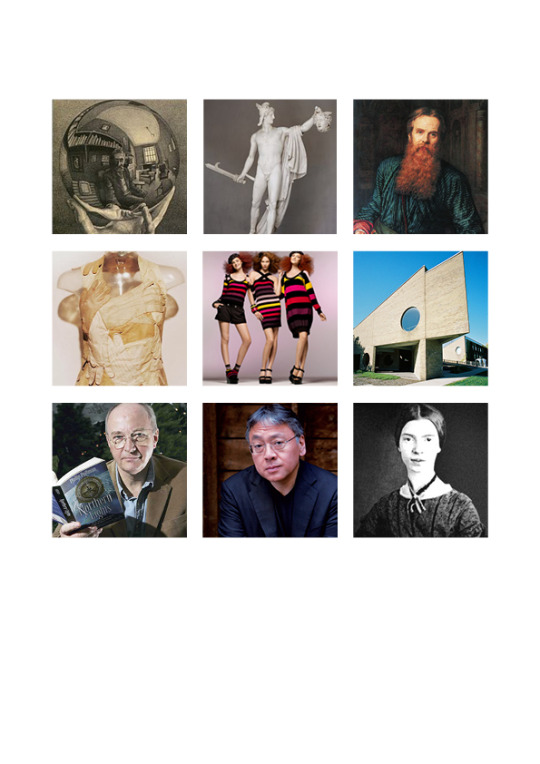
1.
M.C. Escher was born in 1898 and died 74 years later in 1972. He was a Dutch artist, who created eye-fooling pieces that made the impossible look believable. He had a meticulously ordered mind and led a meticulously ordered life. He associated with friends from school, both mathematicians and academics as much as he associated with other artists. This may have influenced the cleverly calculated art piece. His studio was in Baarn, a small town to the south-east of Amsterdam. He would take occasional trips to Italy or the Mediterranean but would always travel in 2nd or 3rd class. He was also awarded a knighthood in 1955, he reluctantly agreed to it and swore never to wear the medal. He loved having some peace and regulated hours to work on his pieces, and was a little frustrated by how popular his pieces were as he would have to take time out from creating new pieces, so he raised his prices in an effort to dampen sales, but it had no effect. He never worked commercially, famously turning down ‘Mr Jagger’s’ plea to design a cover for the rolling stones album. Although Escher's work today is quite revolutionary, at the time his work was slow to be appreciated by the art world, his works becoming greatly popular in the 1960s. His increasing fame was partly due to his appeal to hippies, who appreciated the mind-bending character of his work.
2.
Antonio Canova was born on the 1st November 1757 in Possagno, the Republic of Venice. He was a neoclassical sculptor who is quite famous for his nude, marble sculptures.He came from a family of stone cutters, allowing him to experiment in his younger years. He had a patron, Senator Falier who placed him under artist Bernardi, who was an influential artist of the time, for 2 years. He received his first major commission in 1782, which was the start of a chain that would gain him international prestige so he could pick and choose his commissions. He died in 1822 and his heart was interred he designed. Source: The works of Antonio Canova in sculpture and modelling by Henry Moses
3.
William Hunt was born in 1827 and died in 1910. He was loyal to the Pre-Raphaelite Brotherhood's enterprise throughout his long career, remaining faithful to the original religious idealism. He was well liked by his colleagues, he was seen as a jolly figure that led to his nickname 'the maniac'. His earlier works were inspired by literature and history. The success of his works 'The Awakening Conscience' and 'The Light of the World' allowed him to travel to the Middle East to paint authentic biblical landscapes and people. He married twice, his first wife died following birth, his second wife being the sister of his first wife. He was quite an unusual character, he was 'out of tune with the prevailing orthodoxy.' This also showed in some of his paintings as he challenged conventional picture-making.
4.
Martin Margiela was born in 1959 in Limbourg, Belgium. He studied at Antwerp's Royal Academy and between 1984 and 1987 was the assisted Jean Paul Gautier. In 1988 Maison Martin Margiela was founded in Paris and in the same year he presented his first collection for spring/summer 1989. Martin Margiela was quite a mysterious person, he was never photographed, never interviewed in person or as an individual. He had his own peculiar but precise vision and is 'one of the most influential and iconoclastic designers to emerge over the past 15 years'. Some of his pieces are quite peculiar, with clothes being made out of other pieces of clothes, like a top made out of gloves sewn together. Sometimes his pieces are a little controversial and made more for a fashion viewing than wearable fashion in the real world.
Sources: 100 Contemporary Fashion Designers
5.
Sonia Rykiel was born in Paris in 1930. Her journey to being a name in fashion was a little different to the norm. When she was pregnant she noticed how there were no sweaters that were flexible enough to cover the journey of pregnancy so in 1962 she created her own line of knitwear. This turned out to be a bit hit and she opened her own boutique. She was very motivated to create fashion that was attractive as it was comfortable for women. Her style tended to be chic with a Parisian style to match. She continued to increase her fashion empire as well as developing a beauty line. She received an Oscar from the Fashion Group International. In 2009 she celebrated 40 years in the fashion industry, keeping to her sexy, shiny and decadent look.
Sources: 100 Contemporary Fashion Designers
6.
Harry Weese was an American architect who was well known for his creations in downtown Chicago and on the Washington, DC, Metro System. He designed for over 60 years starting in the 1920s before dying in 1998. His works range from single-family homes, churches, transit buildings, stores, educational facilities, and urban environments. One of his popular pieces that he created was the village hall in Oak Park, Illinois. It took 3 years, from 1971-1974, to complete the 70,000 sq ft. This building is seen as one of the 'major architectural masterpieces articulating the relationship between government and people governed.'
Sources: Article: http://web.b.ebscohost.com/ehost/pdfviewer/pdfviewer?vid=1&sid=365261ff-e87f-4263-adbf-114b01db8793%40sessionmgr102&hid=125
Book: Architecture in the seventies by Udo Kultermann
7.
Philip Pullman was born on 19th October 1946 in Norwich. He followed the itinerant route of his father’s RAF career. Journeying between positions was by sea, and this gave Pullman the chance to start storytelling to entertain his younger brother on the long journeys. His father died in an air crash, leaving Pullman and his brother to go live with his grandparents in Norfolk.This period was very influential to Pullman, as his grandfather was a clergyman and a great storyteller. When his mother remarried they moved to Australia. Here he gained his love for comics and graphic novels, for which built his love for illustrations, and he saw them as something important to go along with a narrative. Pullman went back to England in secondary school and started to write poetry, influenced by Dylan Thomas and the Metaphysical poets. His teacher who introduced him to his early literary influences was acknowledged at the end of The Amber Spyglass. He went to the University of Oxford to read English. Once graduating he took on various jobs and decided to train to be a teacher, even though he knew he wanted to write novels. He taught at a middle school, where the curriculum was very open and allowed to concentrate on his storytelling. Working in a school allowed him to refine his oral storytelling. Being in this situation made his try to write novels for children, and all of his works would refine his skills into making His Dark Materials trilogy. His successes in writing for children allowed him to become a full-time writer.
Sources: Continuum Contemporaries: Phillip Pullman’s His Dark Materials Trilogy by Claire Squires
8.
Kazuo Ishiguro was born in Nagasaki, Japan on November 8th, 1954. When he was 5 his family moved to Britain for his father's job, which was originally meant to be temporary by became permanent. He studied English and Philosophy at the University of Kent graduating with a B.A Honors in 1978. After University he travelled to North America for a year, when he returned to England, he took on various jobs. He took steps towards a literary career in 1979 when he entered a creative writing program at the University of East Anglia. He received his M.A in 1980 and from there he wrote short stories and television scripts. He became a British Citizen in 1982 the same year he published A Pale View of Hills the first of five award-winning novels that have brought him worldwide fame.
Sources: Continuum Contemporaries Kazuo Ishiguro's The Remains of the Day by Adam Parkes
9.
Emily Dickinson was born on the 10th December 1830 in Amherst, Massachusetts. She had an education at Amherst Academy and Mount Holyoke Seminary. She grew up with her family's extensive library, which helped to develop her love for literacy. In her early twenties, she had developed close friendships where they would read and discuss books. One of her friends, Benjamin Newton supported and encouraged her in becoming a poet. Emily Dickinson was unrecognised in life when it came to poetry as she was quite exclusive. Her poetry was only published after her death on 15th May 1886, by her sister. Even today she is one of the biggest figures in American Literature.
Source: Emily Dickinson by Joan Kirkby
0 notes